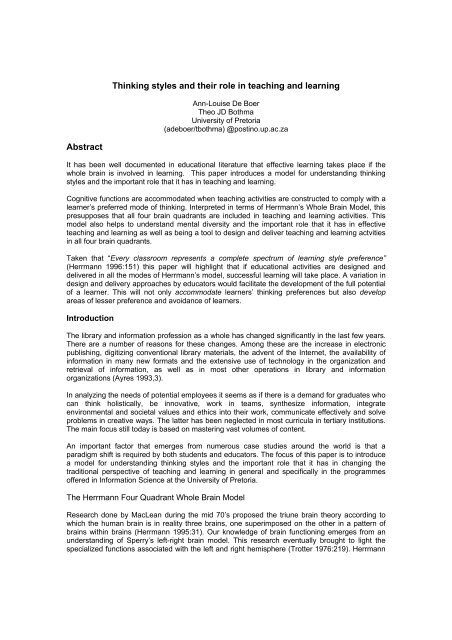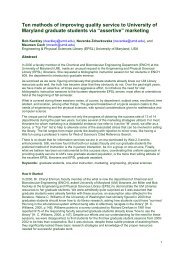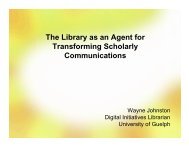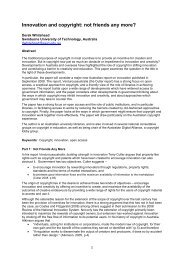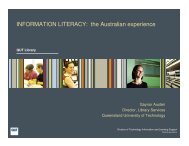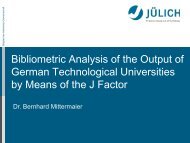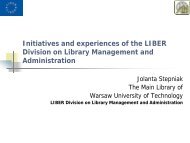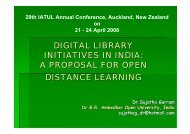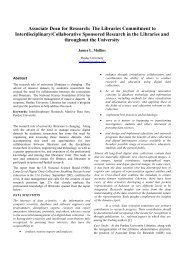Thinking styles and their role in teaching and learning Abstract - IATUL
Thinking styles and their role in teaching and learning Abstract - IATUL
Thinking styles and their role in teaching and learning Abstract - IATUL
You also want an ePaper? Increase the reach of your titles
YUMPU automatically turns print PDFs into web optimized ePapers that Google loves.
<strong>Th<strong>in</strong>k<strong>in</strong>g</strong> <strong>styles</strong> <strong>and</strong> <strong>their</strong> <strong>role</strong> <strong>in</strong> teach<strong>in</strong>g <strong>and</strong> learn<strong>in</strong>g<br />
Ann-Louise De Boer<br />
Theo JD Bothma<br />
University of Pretoria<br />
(adeboer/tbothma) @post<strong>in</strong>o.up.ac.za<br />
<strong>Abstract</strong><br />
It has been well documented <strong>in</strong> educational literature that effective learn<strong>in</strong>g takes place if the<br />
whole bra<strong>in</strong> is <strong>in</strong>volved <strong>in</strong> learn<strong>in</strong>g. This paper <strong>in</strong>troduces a model for underst<strong>and</strong><strong>in</strong>g th<strong>in</strong>k<strong>in</strong>g<br />
<strong>styles</strong> <strong>and</strong> the important <strong>role</strong> that it has <strong>in</strong> teach<strong>in</strong>g <strong>and</strong> learn<strong>in</strong>g.<br />
Cognitive functions are accommodated when teach<strong>in</strong>g activities are constructed to comply with a<br />
learner’s preferred mode of th<strong>in</strong>k<strong>in</strong>g. Interpreted <strong>in</strong> terms of Herrmann’s Whole Bra<strong>in</strong> Model, this<br />
presupposes that all four bra<strong>in</strong> quadrants are <strong>in</strong>cluded <strong>in</strong> teach<strong>in</strong>g <strong>and</strong> learn<strong>in</strong>g activities. This<br />
model also helps to underst<strong>and</strong> mental diversity <strong>and</strong> the important <strong>role</strong> that it has <strong>in</strong> effective<br />
teach<strong>in</strong>g <strong>and</strong> learn<strong>in</strong>g as well as be<strong>in</strong>g a tool to design <strong>and</strong> deliver teach<strong>in</strong>g <strong>and</strong> learn<strong>in</strong>g actvities<br />
<strong>in</strong> all four bra<strong>in</strong> quadrants.<br />
Taken that “Every classroom represents a complete spectrum of learn<strong>in</strong>g style preference”<br />
(Herrmann 1996:151) this paper will highlight that if educational activities are designed <strong>and</strong><br />
delivered <strong>in</strong> all the modes of Herrmann’s model, successful learn<strong>in</strong>g will take place. A variation <strong>in</strong><br />
design <strong>and</strong> delivery approaches by educators would facilitate the development of the full potential<br />
of a learner. This will not only accommodate learners’ th<strong>in</strong>k<strong>in</strong>g preferences but also develop<br />
areas of lesser preference <strong>and</strong> avoidance of learners.<br />
Introduction<br />
The library <strong>and</strong> <strong>in</strong>formation profession as a whole has changed significantly <strong>in</strong> the last few years.<br />
There are a number of reasons for these changes. Among these are the <strong>in</strong>crease <strong>in</strong> electronic<br />
publish<strong>in</strong>g, digitiz<strong>in</strong>g conventional library materials, the advent of the Internet, the availability of<br />
<strong>in</strong>formation <strong>in</strong> many new formats <strong>and</strong> the extensive use of technology <strong>in</strong> the organization <strong>and</strong><br />
retrieval of <strong>in</strong>formation, as well as <strong>in</strong> most other operations <strong>in</strong> library <strong>and</strong> <strong>in</strong>formation<br />
organizations (Ayres 1993,3).<br />
In analyz<strong>in</strong>g the needs of potential employees it seems as if there is a dem<strong>and</strong> for graduates who<br />
can th<strong>in</strong>k holistically, be <strong>in</strong>novative, work <strong>in</strong> teams, synthesize <strong>in</strong>formation, <strong>in</strong>tegrate<br />
environmental <strong>and</strong> societal values <strong>and</strong> ethics <strong>in</strong>to <strong>their</strong> work, communicate effectively <strong>and</strong> solve<br />
problems <strong>in</strong> creative ways. The latter has been neglected <strong>in</strong> most curricula <strong>in</strong> tertiary <strong>in</strong>stitutions.<br />
The ma<strong>in</strong> focus still today is based on master<strong>in</strong>g vast volumes of content.<br />
An important factor that emerges from numerous case studies around the world is that a<br />
paradigm shift is required by both students <strong>and</strong> educators. The focus of this paper is to <strong>in</strong>troduce<br />
a model for underst<strong>and</strong><strong>in</strong>g th<strong>in</strong>k<strong>in</strong>g <strong>styles</strong> <strong>and</strong> the important <strong>role</strong> that it has <strong>in</strong> chang<strong>in</strong>g the<br />
traditional perspective of teach<strong>in</strong>g <strong>and</strong> learn<strong>in</strong>g <strong>in</strong> general <strong>and</strong> specifically <strong>in</strong> the programmes<br />
offered <strong>in</strong> Information Science at the University of Pretoria.<br />
The Herrmann Four Quadrant Whole Bra<strong>in</strong> Model<br />
Research done by MacLean dur<strong>in</strong>g the mid 70’s proposed the triune bra<strong>in</strong> theory accord<strong>in</strong>g to<br />
which the human bra<strong>in</strong> is <strong>in</strong> reality three bra<strong>in</strong>s, one superimposed on the other <strong>in</strong> a pattern of<br />
bra<strong>in</strong>s with<strong>in</strong> bra<strong>in</strong>s (Herrmann 1995:31). Our knowledge of bra<strong>in</strong> function<strong>in</strong>g emerges from an<br />
underst<strong>and</strong><strong>in</strong>g of Sperry’s left-right bra<strong>in</strong> model. This research eventually brought to light the<br />
specialized functions associated with the left <strong>and</strong> right hemisphere (Trotter 1976:219). Herrmann
(1996:42) po<strong>in</strong>ted out, that although each hemisphere is specialized <strong>in</strong> a different way, the<br />
physical connections secure <strong>in</strong>tegrated bra<strong>in</strong> activity. Accord<strong>in</strong>g to Gazzagnia (1998:35) ongo<strong>in</strong>g<br />
research has reaffirmed that:<br />
‘The two hemispheres control vastly different aspects of thought <strong>and</strong> action.<br />
Each half has its own specialization <strong>and</strong> thus its own limitations <strong>and</strong><br />
advantages’.<br />
These theories gave impetus to the development of Herrmann’s whole bra<strong>in</strong> model. Herrmann<br />
used the left/right theory, the triune theory <strong>and</strong> the physical connections between the left <strong>and</strong> right<br />
hemispheres <strong>and</strong> between the upper <strong>and</strong> lower parts of the bra<strong>in</strong> to construct his whole bra<strong>in</strong><br />
model.<br />
The four quadrants of the Herrmann model represent the four th<strong>in</strong>k<strong>in</strong>g structures of the bra<strong>in</strong>. The<br />
left <strong>and</strong> right hemispheres (Sperry’s work) represent our cerebral processes <strong>and</strong> the two halves of<br />
the limbic system (MacLean <strong>and</strong> Herrmann’s work) represents our more visceral (feel<strong>in</strong>g based)<br />
processes. The cerebral mode is the more cognitive, <strong>in</strong>tellectual part of our th<strong>in</strong>k<strong>in</strong>g processes<br />
<strong>and</strong> the limbic mode is the more structured visceral <strong>and</strong> emotional part of our th<strong>in</strong>k<strong>in</strong>g processes<br />
(Herrmann 1995:40). Although an <strong>in</strong>dividual may favour cognitive activities associated with a<br />
specific quadrant, ‘ both hemispheres contribute to everyth<strong>in</strong>g, but contribute differently’ (Ornste<strong>in</strong><br />
1997:94).<br />
Accord<strong>in</strong>g to Herrmann (1995, 1996) a preference for the A-quadrant (left cerebral mode) means<br />
that a person favours activities that <strong>in</strong>volve logical, analytical, fact-based <strong>in</strong>formation. A<br />
preference for the B-quadrant (left limbic mode) implies a l<strong>in</strong>ear approach to activities. Individuals<br />
with a B-quadrant preference favour organized, sequential planned <strong>and</strong> detailed <strong>in</strong>formation.<br />
They are conservative <strong>in</strong> <strong>their</strong> actions <strong>and</strong> like to keep th<strong>in</strong>gs as they are. A preference for the C-<br />
quadrant (processes of the right limbic mode) <strong>in</strong>dicates favour<strong>in</strong>g <strong>in</strong>formation that is <strong>in</strong>terpersonal<br />
feel<strong>in</strong>g-based <strong>and</strong> <strong>in</strong>volves emotion. A preference for the D-quadrant (processes of the right<br />
cerebral mode) is ma<strong>in</strong>ly characterized by holistic <strong>and</strong> conceptual approach <strong>in</strong> th<strong>in</strong>k<strong>in</strong>g.<br />
This model helps to underst<strong>and</strong> mental diversity <strong>and</strong> the important <strong>role</strong> that it has not only for<br />
effective teach<strong>in</strong>g <strong>and</strong> learn<strong>in</strong>g, but as well as a tool to design <strong>and</strong> deliver teach<strong>in</strong>g <strong>and</strong> learn<strong>in</strong>g<br />
activities <strong>in</strong> all four bra<strong>in</strong> quadrants. The model further <strong>in</strong>dicates clearly the iterative nature of the<br />
activities <strong>and</strong> the correlation of the physiology of the <strong>in</strong>terconnected bra<strong>in</strong>.<br />
These specialized mental modes function together situationally <strong>and</strong> <strong>in</strong>teractively mak<strong>in</strong>g up a<br />
whole bra<strong>in</strong> <strong>in</strong> which one or more parts become naturally dom<strong>in</strong>ant. The dom<strong>in</strong>ance between the<br />
paired structures of the bra<strong>in</strong> provides the basis for measur<strong>in</strong>g the level of dom<strong>in</strong>ance. The<br />
Herrmann Bra<strong>in</strong> dom<strong>in</strong>ance Instrument (HBDI) is an assessment tool that quantifies the degree of<br />
a person’s preference for specific th<strong>in</strong>k<strong>in</strong>g.<br />
The Herrmann Bra<strong>in</strong> Dom<strong>in</strong>ance Instrument Tool (HBDI)<br />
Based on extensive research which spans 20 years, Herrmann (1995, 1996) developed an<br />
assessment tool that quantifies the degree of a person’s preference for a specific th<strong>in</strong>k<strong>in</strong>g style –<br />
the Herrmann Bra<strong>in</strong> Dom<strong>in</strong>ance Instrument (HBDI). The results are displayed on a four-quadrant<br />
grid. It takes the form of a survey consist<strong>in</strong>g of 120 questions to be completed by an <strong>in</strong>dividual.<br />
Although Herrmann discusses his model as a metaphor, the bra<strong>in</strong>-based quadrant is aligned with,<br />
<strong>and</strong> supported by various research projects <strong>and</strong> is used a measur<strong>in</strong>g tool for th<strong>in</strong>k<strong>in</strong>g preferences<br />
of <strong>in</strong>dividuals. Because bra<strong>in</strong> dom<strong>in</strong>ance is not solely predeterm<strong>in</strong>ed genetically, but is a result of<br />
genetic <strong>in</strong>heritance <strong>and</strong> parent<strong>in</strong>g <strong>and</strong> teach<strong>in</strong>g, life experiences <strong>and</strong> cultural <strong>in</strong>fluences, bra<strong>in</strong><br />
dom<strong>in</strong>ance is natural <strong>and</strong> normal for all human be<strong>in</strong>gs. This means that bra<strong>in</strong> dom<strong>in</strong>ance<br />
<strong>in</strong>fluences all four specialized th<strong>in</strong>k<strong>in</strong>g structures of the bra<strong>in</strong> <strong>and</strong> not just the two hemispheres.<br />
To date, more that two million HBDI profiles have been done world-wide (Lumsda<strong>in</strong>e, Lumsda<strong>in</strong>e
<strong>and</strong> Schellnut 1999:52). A database of profiles is kept at the headquarters of Herrmann<br />
International <strong>in</strong> the USA as well as <strong>in</strong> France.<br />
It must be outl<strong>in</strong>ed that the HBDI does not test competencies but gives an <strong>in</strong>dication of<br />
preferences <strong>and</strong> potential competencies. Herrmann (1995:76) po<strong>in</strong>ts out that:<br />
“profiles are neither good nor bad, right or wrong. The <strong>in</strong>strument measures<br />
preferences for a mental activity, which is entirely different from competence<br />
<strong>in</strong> perform<strong>in</strong>g it.”<br />
Although the HBDI was orig<strong>in</strong>ally developed for adult users <strong>in</strong> a corporate environment, it has<br />
been successfully used with tertiary students (Lumsda<strong>in</strong>e & Lumsda<strong>in</strong>e 1995, De Boer & Steyn<br />
1999, De Boer & Van den Berg 2000, De Boer, Coetzee & Coetzee 2001).<br />
<strong>Th<strong>in</strong>k<strong>in</strong>g</strong> style preferences <strong>and</strong> learn<strong>in</strong>g style models<br />
Students arrive at tertiary <strong>in</strong>stitutions with th<strong>in</strong>k<strong>in</strong>g style preferences that have been established<br />
through school<strong>in</strong>g <strong>and</strong> life experiences. These exist<strong>in</strong>g preferences are <strong>in</strong>fluential with regard to<br />
all the cognitive activities <strong>in</strong> which students are engaged. A th<strong>in</strong>k<strong>in</strong>g style preference leads to a<br />
learn<strong>in</strong>g style preference <strong>and</strong> <strong>in</strong> turn determ<strong>in</strong>es a student’s dom<strong>in</strong>ant cognitive mode <strong>in</strong> which<br />
he/she communicates <strong>and</strong> receives <strong>in</strong>formation. The notion of learn<strong>in</strong>g style <strong>and</strong> learn<strong>in</strong>g style<br />
models are well documented <strong>in</strong> research. The Myers-Briggs Type Indicator (MBI) classifies<br />
students accord<strong>in</strong>g to <strong>their</strong> preferences on scales derived from Carl Jung’s theory of<br />
psychological types. Students may be extroverts or <strong>in</strong>troverts, sensors or <strong>in</strong>tuitors; th<strong>in</strong>kers or<br />
feelers; <strong>and</strong> judges or perceivers. Kolb’s learn<strong>in</strong>g Style Inventory classifies students as hav<strong>in</strong>g a<br />
preference for concrete experience, abstract conceptualization, active experimentation, or<br />
reflective observation. The Herrmann Four Quadrant Whole Bra<strong>in</strong> Model, however is the only<br />
<strong>in</strong>strument that quantifies a person’s preference for th<strong>in</strong>k<strong>in</strong>g <strong>in</strong> four different modes based on the<br />
task-specialised function<strong>in</strong>g of the physical bra<strong>in</strong> (Herrmann 1995:72, 350).<br />
Effective Teach<strong>in</strong>g <strong>and</strong> Effective Learn<strong>in</strong>g<br />
It has been documented (Knowles 1990, Buzan 1991, Jensen 1996, Ornste<strong>in</strong> 1997) that effective<br />
learn<strong>in</strong>g takes place if the whole bra<strong>in</strong> is <strong>in</strong>volved <strong>in</strong> learn<strong>in</strong>g. Interpreted <strong>in</strong> terms of Herrmann’s<br />
model this presupposes that all four quadrants are <strong>in</strong>cluded <strong>in</strong> teach<strong>in</strong>g <strong>and</strong> learn<strong>in</strong>g activities.<br />
Complementary to Herrmann’s model, Lumsda<strong>in</strong>e <strong>and</strong> Lumsda<strong>in</strong>e (1995) identified the follow<strong>in</strong>g<br />
four modes of (tertiary) students’ learn<strong>in</strong>g.<br />
• External learn<strong>in</strong>g is related to teach<strong>in</strong>g from authority through lectures <strong>and</strong> text books. It<br />
is predom<strong>in</strong>antly A-quadrant learn<strong>in</strong>g.<br />
• Internal learn<strong>in</strong>g can be described as an <strong>in</strong>sight, a visualization, the synthesis of data or<br />
through the underst<strong>and</strong><strong>in</strong>g of concepts holistically or <strong>in</strong>tuitively. This is predom<strong>in</strong>antly D-<br />
quadrant learn<strong>in</strong>g.<br />
• Interactive learn<strong>in</strong>g is brought about by discussion, h<strong>and</strong>s-on activities <strong>and</strong> sensorybased<br />
experiments where a student can try, fail, retry with an opportunity for verbal<br />
feedback <strong>and</strong> encouragement. Interactive learn<strong>in</strong>g is predom<strong>in</strong>antly C-quadrant learn<strong>in</strong>g.<br />
• Procedural learn<strong>in</strong>g is characterized by methodical step-by-step test<strong>in</strong>g of what is be<strong>in</strong>g<br />
taught as well as practice <strong>and</strong> repetition to improve skills <strong>and</strong> competence. It is<br />
predom<strong>in</strong>antly B-quadrant learn<strong>in</strong>g.<br />
Cognitive functions are accommodated when teach<strong>in</strong>g activities are constructed to comply with a<br />
learner’s preferred mode of th<strong>in</strong>k<strong>in</strong>g/learn<strong>in</strong>g. Cognitive functions are optimally utilized when<br />
learn<strong>in</strong>g activities are constructed <strong>in</strong> such a way that the cognitive functions associated with all<br />
four quadrants of the Herrmann model are used. However, it should be borne <strong>in</strong> m<strong>in</strong>d that
teach<strong>in</strong>g <strong>and</strong> learn<strong>in</strong>g are done with<strong>in</strong> the context of the complexity as illustrated <strong>in</strong> the Herrmann<br />
extended model for teach<strong>in</strong>g <strong>and</strong> learn<strong>in</strong>g.<br />
[Insert figure 1 here]<br />
Figure 1 The Whole Bra<strong>in</strong> Teach<strong>in</strong>g <strong>and</strong> Learn<strong>in</strong>g Model (Herrmann 1995:155)<br />
In this model the learner/teacher is represented <strong>in</strong> the centre as whole bra<strong>in</strong>ed <strong>and</strong> with<strong>in</strong> the<br />
broader cultural <strong>and</strong> social environment. The arrows <strong>in</strong>dicate the iterative nature of the activities<br />
as they correlate with the physiology of the <strong>in</strong>terconnected bra<strong>in</strong>. The left (structured) mode is<br />
categorized by processes deal<strong>in</strong>g with logical, rational, critical, quantitative issues <strong>and</strong> activities.<br />
The procedural planned, sequential <strong>and</strong> organized elements of the learn<strong>in</strong>g/teach<strong>in</strong>g activities are<br />
found <strong>in</strong> the structured left mode. The learn<strong>in</strong>g/teach<strong>in</strong>g activities of the left mode are depicted <strong>in</strong><br />
the cultural <strong>and</strong> social environment by achievements, fact-based knowledge <strong>and</strong> traditional ways.<br />
The experimental right mode is categorized by processes deal<strong>in</strong>g with visual, conceptual,<br />
emotional <strong>and</strong> <strong>in</strong>terpersonal activities. In the cultural <strong>and</strong> social environment the learn<strong>in</strong>g/teach<strong>in</strong>g<br />
activities of the right mode can be described as participative <strong>and</strong> future orientated. The <strong>in</strong>clusion<br />
of all these modes <strong>in</strong> learn<strong>in</strong>g/teach<strong>in</strong>g activities comprises a full range of activities.<br />
In a study by Trigwell, Prosser <strong>and</strong> Waterhouse (1999) it was shown that qualitatively different<br />
approaches to teach<strong>in</strong>g are associated with qualitatively different approaches to student learn<strong>in</strong>g.<br />
In <strong>their</strong> study they considered an <strong>in</strong>formation transmission/teacher-focused approach <strong>in</strong><br />
comparison with a conceptual change/student-focused approach. Their results are<br />
complementary to Herrmann’s model. Viewed <strong>in</strong> terms of a whole bra<strong>in</strong> approach to teach<strong>in</strong>g <strong>and</strong><br />
learn<strong>in</strong>g, the <strong>in</strong>formation transmission/teacher-focused approach represents an approach<br />
focus<strong>in</strong>g only on cognitive modes associated with the A <strong>and</strong> B-quadrants <strong>in</strong> Herrmann’s model.<br />
However, the conceptual change/student-focused approach also <strong>in</strong>cludes cognitive modes<br />
associated with the C <strong>and</strong> D-quadrants of the Herrmann model.<br />
Accord<strong>in</strong>g to Herrmann his model serves as a strategic tool to design <strong>and</strong> deliver teach<strong>in</strong>g <strong>and</strong><br />
learn<strong>in</strong>g activities. Educational activities that implement all the modes of Herrmann’s model will<br />
ensure that learners’ preferred th<strong>in</strong>k<strong>in</strong>g <strong>styles</strong> are accommodated <strong>and</strong> less preferred th<strong>in</strong>k<strong>in</strong>g<br />
<strong>styles</strong> are developed. An application of Herrmann’s extended model <strong>in</strong> teach<strong>in</strong>g necessitates that<br />
educators become aware of <strong>their</strong> own th<strong>in</strong>k<strong>in</strong>g preferences <strong>and</strong> the implications thereof for <strong>their</strong><br />
teach<strong>in</strong>g practices. Cognitive functions are accommodated when teach<strong>in</strong>g activities are<br />
constructed to comply with a learner’s preferred mode of th<strong>in</strong>k<strong>in</strong>g. Interpreted <strong>in</strong> terms of<br />
Herrmann’s Whole Bra<strong>in</strong> Model, this presupposes that all four bra<strong>in</strong> quadrants are <strong>in</strong>cluded <strong>in</strong><br />
teach<strong>in</strong>g <strong>and</strong> learn<strong>in</strong>g activities.<br />
The authors f<strong>in</strong>d themselves <strong>in</strong> agreement with Felder (1996:18) <strong>and</strong> f<strong>in</strong>d his observation fully<br />
applicable to the whole bra<strong>in</strong> model:<br />
“If professors teach exclusively <strong>in</strong> a manner that favours <strong>their</strong> students’ less<br />
preferred learn<strong>in</strong>g style modes, the students’ discomfort level may be great<br />
enough to <strong>in</strong>terfere with <strong>their</strong> learn<strong>in</strong>g. On the other h<strong>and</strong>, if professors teach<br />
exclusively <strong>in</strong> <strong>their</strong> students’ preferred modes, the students may not develop<br />
the mental dexterity they need to reach <strong>their</strong> potential for achievement <strong>in</strong><br />
school <strong>and</strong> as professionals.”<br />
Research projects conducted at the University of Pretoria<br />
• Educators enrolled for the Diploma <strong>in</strong> Tertiary Instruction <strong>in</strong> 1999
A research project was undertaken <strong>in</strong> which educators enrolled for a diploma <strong>in</strong> tertiary education<br />
were <strong>in</strong>troduced to the whole bra<strong>in</strong> concept <strong>and</strong> were given <strong>in</strong>formation perta<strong>in</strong><strong>in</strong>g to the<br />
Herrmann Bra<strong>in</strong> Dom<strong>in</strong>ance <strong>in</strong>strument (HBDI). For a relatively small sample of <strong>in</strong>dividuals (17),<br />
the results revealed a diversity of th<strong>in</strong>k<strong>in</strong>g style preferences among the <strong>in</strong>dividual educators<br />
display<strong>in</strong>g a composite whole <strong>in</strong> th<strong>in</strong>k<strong>in</strong>g preferences <strong>in</strong> all four quadrants (De Boer, Steyn & Du<br />
Toit 2001:192). This is <strong>in</strong> accordance with research f<strong>in</strong>d<strong>in</strong>gs perta<strong>in</strong><strong>in</strong>g to Herrmann’s model. As<br />
po<strong>in</strong>ted out by Knowles (1990:245):<br />
“people are equally distributed throughout the teach<strong>in</strong>g <strong>and</strong> learn<strong>in</strong>g model <strong>in</strong><br />
terms of <strong>their</strong> mental preferences”.<br />
.<br />
Herrmann (1996:47) affirms that:<br />
“the composite of <strong>in</strong>dividual profiles represents a highly diverse, but well<br />
balanced, distribution across the four quadrants of the whole bra<strong>in</strong> model”.<br />
Any lecture-type of <strong>in</strong>struction focuses ma<strong>in</strong>ly on the cognitive modes <strong>in</strong> the A-quadrant. A<br />
variation <strong>in</strong> design <strong>and</strong> delivery approaches would facilitate learn<strong>in</strong>g <strong>in</strong> all four the specialised<br />
quadrants. Saroyan <strong>and</strong> Snell (1997) concluded that it seems as if the <strong>in</strong>clusion of cognitive<br />
modes from the other quadrants made it more whole bra<strong>in</strong>ed <strong>in</strong> approach which may contribute to<br />
it be<strong>in</strong>g better perceived by students. Structur<strong>in</strong>g educational activities to <strong>in</strong>corporate the<br />
expectations of learners <strong>in</strong> all four quadrants would facilitate the development of the full potential<br />
of learners. This will accommodate learners’ th<strong>in</strong>k<strong>in</strong>g preferences <strong>and</strong> areas of lesser preferences<br />
<strong>and</strong> avoidance are activated. Accord<strong>in</strong>g to Knowles (1990:241) the concept of whole bra<strong>in</strong><br />
teach<strong>in</strong>g <strong>and</strong> learn<strong>in</strong>g provides the basis for bridg<strong>in</strong>g the gap between the unique <strong>in</strong>dividual<br />
learner th<strong>in</strong>k<strong>in</strong>g style <strong>and</strong> the design <strong>and</strong> delivery of the learn<strong>in</strong>g by the educator.<br />
• First-year students study<strong>in</strong>g a first course <strong>in</strong> Crim<strong>in</strong>ology<br />
The second project <strong>in</strong>cluded 68 students registered for a first course <strong>in</strong> Crim<strong>in</strong>ology. Results from<br />
this project (De Boer & Van den Berg 2001:118) reveal that a wide range of th<strong>in</strong>k<strong>in</strong>g preferences<br />
exists amongst these students. The composite profile for the group <strong>in</strong>dicates preferred modes of<br />
th<strong>in</strong>k<strong>in</strong>g <strong>in</strong> all four quadrants. This confirms the research f<strong>in</strong>d<strong>in</strong>gs of Knowles (1990:245) claim<strong>in</strong>g<br />
that people are equally distributed throughout the teach<strong>in</strong>g <strong>and</strong> learn<strong>in</strong>g model <strong>in</strong> terms of <strong>their</strong><br />
mental preferences.<br />
This implies that curriculum designers <strong>and</strong> educators must be careful not to make unfounded<br />
assumptions about learners <strong>in</strong> the classroom. The project reveals <strong>in</strong>deed that there is a<br />
distribution of learn<strong>in</strong>g preferences <strong>in</strong> all quadrants <strong>and</strong> that all modes are equally represented.<br />
The research project endorses documented research f<strong>in</strong>d<strong>in</strong>gs (Herrmann 1995:151) that just as<br />
there is a “distribution of th<strong>in</strong>k<strong>in</strong>g preferences across the spectrum of all four quadrants <strong>in</strong> the<br />
classroom, there is also a distribution of learn<strong>in</strong>g avoidance across the four quadrants”. Learn<strong>in</strong>g<br />
avoidance may even be more significant to educators than learn<strong>in</strong>g preferences because a<br />
“turned off learner is a waste of educational time <strong>and</strong> effort” (Herrmann 1996:152). Therefore the<br />
greater the alignment between the th<strong>in</strong>k<strong>in</strong>g preference of the educator <strong>and</strong> the th<strong>in</strong>k<strong>in</strong>g<br />
preference of the learner, the more competencies will be acquired by the learner. On the other<br />
h<strong>and</strong> the greater the misalignment the fewer competencies will be acquired.<br />
In order to develop the full potential of learners, whole bra<strong>in</strong> learn<strong>in</strong>g should form the basis of<br />
teach<strong>in</strong>g practices. This approach will assist all students to acquire skills over a wide spectrum<br />
<strong>and</strong> to develop <strong>and</strong> grow <strong>in</strong> areas of lesser preference (De Boer & Van den Berg 2001:119).<br />
• First year students enrolled for a degree <strong>in</strong> Civil Eng<strong>in</strong>eer<strong>in</strong>g
A strong emphasis, backed by <strong>in</strong>dustry, is on the improvement of the softer, “non-technical” skills<br />
of eng<strong>in</strong>eer<strong>in</strong>g students. American, Australian, British <strong>and</strong> South African studies reveal that<br />
employers believe that entry level employees are deficient <strong>in</strong> the broader non-technical skills <strong>and</strong><br />
that educational <strong>in</strong>stitutions need to place more emphasis on teach<strong>in</strong>g these skills (Busse 1999).<br />
Eng<strong>in</strong>eer<strong>in</strong>g educational programmes have traditionally done exceptionally well <strong>in</strong> develop<strong>in</strong>g<br />
analytical <strong>and</strong> technical competencies of students (Lumsda<strong>in</strong>e & Lumsda<strong>in</strong>e 1995) but little has<br />
been done for the development of social th<strong>in</strong>k<strong>in</strong>g <strong>and</strong> communication skills.<br />
This trend to create a balance between technical <strong>and</strong> non-technical aspects <strong>in</strong> the tra<strong>in</strong><strong>in</strong>g <strong>and</strong><br />
education of eng<strong>in</strong>eers is evident <strong>in</strong> eng<strong>in</strong>eer<strong>in</strong>g education <strong>and</strong> curriculum designs worldwide.<br />
In order to facilitate the development of non-technical skills of first year students a teach<strong>in</strong>g <strong>and</strong><br />
learn<strong>in</strong>g facilitation strategy based on an awareness of Herrmann’s four quadrant whole bra<strong>in</strong><br />
pr<strong>in</strong>ciples was <strong>in</strong>troduced <strong>in</strong> the Department of Civil Eng<strong>in</strong>eer<strong>in</strong>g <strong>in</strong> 1999. The study <strong>in</strong>cluded 50<br />
first year civil eng<strong>in</strong>eer<strong>in</strong>g students. The HBDI was used to give students <strong>in</strong>sight <strong>in</strong>to <strong>their</strong> own<br />
th<strong>in</strong>k<strong>in</strong>g preferences, to determ<strong>in</strong>e the homogeneity/diversity of the group of students <strong>and</strong> to give<br />
educators <strong>in</strong>sight <strong>in</strong>to the distribution of <strong>their</strong> student’s preferred modes of th<strong>in</strong>k<strong>in</strong>g.<br />
As <strong>in</strong> the previous research f<strong>in</strong>d<strong>in</strong>gs, the profiles of the students, displayed an array of<br />
preferences distributed over all four quadrants of the Herrmann’s Whole Bra<strong>in</strong> Model (Horak,<br />
Steyn & De Boer 2001:202). On average, the dom<strong>in</strong>ant th<strong>in</strong>k<strong>in</strong>g preferences of the group<br />
revealed a dist<strong>in</strong>ct tilt towards the preference for the th<strong>in</strong>k<strong>in</strong>g modes of the left hemisphere. The<br />
composite profile of the th<strong>in</strong>k<strong>in</strong>g modes reveal a strong preference for the upper left A-quadrant,<br />
followed by a preference for the lower left B-quadrant, followed by a lesser preference for the<br />
th<strong>in</strong>k<strong>in</strong>g modes of the upper right D-quadrant <strong>and</strong> a low preference for the lower right C-quadrant<br />
mode. Individual preferences however revealed strong preferences <strong>in</strong> all four quadrants. These<br />
f<strong>in</strong>d<strong>in</strong>gs are <strong>in</strong> accordance with those of Lumsda<strong>in</strong>e & Lumsda<strong>in</strong>e (1995) who conducted a<br />
research project on a large scale with students enrolled <strong>in</strong> a Faculty of Eng<strong>in</strong>eer<strong>in</strong>g <strong>in</strong> the United<br />
States of America.<br />
For the eng<strong>in</strong>eer<strong>in</strong>g students, as well as the educators, it became apparent that traditional<br />
approaches to educational design <strong>and</strong> delivery could fall short of desired results when deal<strong>in</strong>g<br />
with a composite group of learners with th<strong>in</strong>k<strong>in</strong>g style preferences distributed across all four<br />
quadrants. After exposure <strong>and</strong> application of the HBDI model it was evident that the students<br />
showed a significant <strong>in</strong>crease <strong>in</strong> socialization <strong>and</strong> group acceptance of the value of diversity were<br />
obvious <strong>in</strong> the projects <strong>and</strong> group work they participated <strong>in</strong>.<br />
• Second year students enrolled for a degree <strong>in</strong> Library <strong>and</strong> Information Science<br />
At the beg<strong>in</strong>n<strong>in</strong>g of 2000 another research project was done on second year students enrolled for<br />
a degree <strong>in</strong> Library <strong>and</strong> Information Science. The aim was also to determ<strong>in</strong>e the th<strong>in</strong>k<strong>in</strong>g<br />
preferences of both students <strong>and</strong> the educators responsible <strong>and</strong> to adapt the curriculum <strong>and</strong><br />
teach<strong>in</strong>g approach if necessary. The research f<strong>in</strong>d<strong>in</strong>gs revealed once aga<strong>in</strong> that both the<br />
educators <strong>and</strong> students have diverse th<strong>in</strong>k<strong>in</strong>g <strong>styles</strong> (De Boer, Coetzee & Coetzee 2001:119).<br />
The composite profile of the group revealed a strong preference for the left lower B-quadrant, <strong>and</strong><br />
right lower C-quadrant.<br />
What was significant <strong>in</strong> the results was the fact that the students’ profiles were not <strong>in</strong> alignment of<br />
what is expected <strong>in</strong> the profession of catalogu<strong>in</strong>g <strong>and</strong> classification. In many fields of the<br />
<strong>in</strong>formation profession, <strong>their</strong> preferred th<strong>in</strong>k<strong>in</strong>g <strong>styles</strong> will be an asset, but what cataloguers <strong>and</strong><br />
those who do subject catalogu<strong>in</strong>g <strong>and</strong> classification need are essentially analytical, technical<br />
proficiency <strong>and</strong> problem solv<strong>in</strong>g skills associated with A-quadrant th<strong>in</strong>k<strong>in</strong>g preferences - skills that<br />
the students’ profiles <strong>in</strong>dicate as be<strong>in</strong>g <strong>their</strong> least preferred modes of th<strong>in</strong>k<strong>in</strong>g.
Attempts should be made to assist all prospective <strong>in</strong>formation workers to acquire these skills as a<br />
matter of urgency with<strong>in</strong> the curriculum <strong>and</strong> educators should seek more opportunities to assist<br />
the students to practice these skills <strong>in</strong> a way that is <strong>in</strong> l<strong>in</strong>e with <strong>their</strong> preferred modes of th<strong>in</strong>k<strong>in</strong>g..<br />
Conclusion<br />
In the research f<strong>in</strong>d<strong>in</strong>gs of numerous small projects at the University of Pretoria the Herrman<br />
Bra<strong>in</strong> Dom<strong>in</strong>ance Instrument (HBDI) proved to be a valid <strong>and</strong> useful diagnostic assessment tool<br />
to determ<strong>in</strong>e the th<strong>in</strong>k<strong>in</strong>g preferences of students <strong>and</strong> educators. The results obta<strong>in</strong>ed correspond<br />
with the universal results of Herrmann’s research as well as others us<strong>in</strong>g this tool.<br />
From our experience students <strong>and</strong> educators have <strong>in</strong>dicated that the four quadrant whole bra<strong>in</strong><br />
concept is an <strong>in</strong>valuable facilitat<strong>in</strong>g tool as a guidel<strong>in</strong>e for design<strong>in</strong>g <strong>and</strong> structur<strong>in</strong>g education.<br />
Traditional teach<strong>in</strong>g methods are no longer effective. Expos<strong>in</strong>g learners to a variety of teach<strong>in</strong>g<br />
methods – all focus<strong>in</strong>g on the same key po<strong>in</strong>ts will facilitate effective learn<strong>in</strong>g. Teach<strong>in</strong>g activities<br />
should ideally be designed to dynamically move back <strong>and</strong> forth <strong>in</strong>corporation all four quadrants of<br />
the whole bra<strong>in</strong> model.<br />
Therefore, what is important for educators is to:<br />
• determ<strong>in</strong>e <strong>their</strong> own th<strong>in</strong>k<strong>in</strong>g preferences <strong>and</strong> evaluate <strong>their</strong> own teach<strong>in</strong>g practice <strong>in</strong><br />
terms of the whole bra<strong>in</strong> teach<strong>in</strong>g <strong>and</strong> learn<strong>in</strong>g model;<br />
• accept the research f<strong>in</strong>d<strong>in</strong>gs that each classroom represents an array of diverse th<strong>in</strong>k<strong>in</strong>g<br />
<strong>and</strong> that by teach<strong>in</strong>g content <strong>in</strong> a whole bra<strong>in</strong> way students’ th<strong>in</strong>k<strong>in</strong>g preferences are<br />
accommodated <strong>and</strong> on the other h<strong>and</strong> students will develop skills <strong>in</strong> <strong>their</strong> lesser preferred<br />
modes of th<strong>in</strong>k<strong>in</strong>g as well, realiz<strong>in</strong>g <strong>their</strong> full potential.<br />
References<br />
Ayres, F.H. 1999. Time for change to the core. Library Association Record 101 (10): 590-592.<br />
Bunderson, C. V. 1995. The validity of the Herrmann Bra<strong>in</strong> Dom<strong>in</strong>ance Instrument, <strong>in</strong> Herrmann,<br />
N (ed) The creative bra<strong>in</strong>. (2 nd edition). Appendix A 337-379. USA: Quebecor Pr<strong>in</strong>t<strong>in</strong>g Book<br />
Group.<br />
Busse, R. 1992. The new basics: today’s employers want the three r’s <strong>and</strong> so much more.<br />
Vocational Education Journal 62 (5): 2931.<br />
De Boer, A. & Steyn, T. 1999. <strong>Th<strong>in</strong>k<strong>in</strong>g</strong> style preferences of underprepared first year students <strong>in</strong><br />
the natural Sciences. South African Journal of Ethnology 22 (3): 97-102.<br />
De Boer, A. Steyn, T. & Du Toit, P.H. 2001. Whole bra<strong>in</strong> teach<strong>in</strong>g for whole bra<strong>in</strong> learners. South<br />
African Journal for Higher Education. 15 (3) 188– 193.<br />
De Boer, A. Coetzee, H.S. Coetzee, H. 2001. Teach<strong>in</strong>g catalogu<strong>in</strong>g <strong>and</strong> classification at the<br />
University of Pretoria: <strong>Th<strong>in</strong>k<strong>in</strong>g</strong> preferences of second year students. Libri 51 (2): 114-123.<br />
Felder, R. 1996. Matters of style. ASEE Prism, December: 18-23.<br />
Gazzaniga, M.S. 1998. The split bra<strong>in</strong> revisited. Scientific American 279 (1): 3539.<br />
Herrmann, N. 1995. The creative bra<strong>in</strong> (2 nd ed). K<strong>in</strong>gsport: Quebecor Pr<strong>in</strong>t<strong>in</strong>g Book Group.<br />
Herrmann, N. 1996. The whole bra<strong>in</strong> bus<strong>in</strong>ess book. New York: McGraw-Hill.
Horak, E., Steyn, T. & De Boer, A. 2001. A four quadrant whole bra<strong>in</strong> approach <strong>in</strong> <strong>in</strong>novat<strong>in</strong>g <strong>and</strong><br />
eng<strong>in</strong>eer<strong>in</strong>g problem solv<strong>in</strong>g to facilitate teach<strong>in</strong>g <strong>and</strong> learn<strong>in</strong>g of eng<strong>in</strong>eer<strong>in</strong>g students. South<br />
African Journal for Higher Education 15 (3): 202-208.<br />
Knowles, M. 1990. The adult learner – a neglected species (4 th edition). USA: Gulf Publish<strong>in</strong>g<br />
Company.<br />
Lumsda<strong>in</strong>e, M. & Lumsda<strong>in</strong>e, E. 1995. <strong>Th<strong>in</strong>k<strong>in</strong>g</strong> preferences of eng<strong>in</strong>eer<strong>in</strong>g students: implications<br />
for curriculum restructur<strong>in</strong>g. Journal of Eng<strong>in</strong>eer<strong>in</strong>g Education 84 (2): 193-204.<br />
Lumsda<strong>in</strong>e, E. Lumsda<strong>in</strong>e, M. & Schellnutt, W. 1999. Creative problem solv<strong>in</strong>g <strong>and</strong> eng<strong>in</strong>eer<strong>in</strong>g<br />
design. New York: College Custom Publish<strong>in</strong>g Group.<br />
Ornste<strong>in</strong>, R 1997. The right m<strong>in</strong>d: mak<strong>in</strong>g sense of the hemispheres. New York: Harcourt Brace &<br />
Company.<br />
Saroyan, A. & Snell, L.S. 1997. Variations <strong>in</strong> lectur<strong>in</strong>g <strong>styles</strong>. Higher Education 33 (1) 85-104.<br />
Shelnut, J.W. Middleton, S. Buch, K. & Lumsda<strong>in</strong>e, M. 1996. Form<strong>in</strong>g student project teams<br />
based on Herrmann Bra<strong>in</strong> Dom<strong>in</strong>ance results. Proceed<strong>in</strong>gs. American Society for Eng<strong>in</strong>eer<strong>in</strong>g<br />
Education (AEE) Annual conference, Wash<strong>in</strong>gton DC.<br />
Trigwell, K, Prosser. M. & Waterhouse, F. 1999. Relations between teachers’ approaches to<br />
teach<strong>in</strong>g <strong>and</strong> students’ approaches to learn<strong>in</strong>g. Higher Education 37 (1): 57-70.


